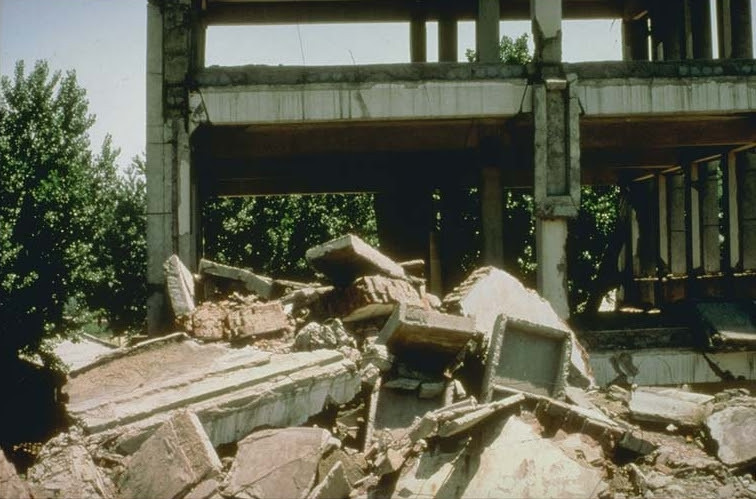O Sismo de Tangshan de 28 de julho de 1976 foi o mais grave terramoto que afligiu o mundo moderno no que diz respeito a vidas perdidas, tendo sido registado uma magnitude de 7,5 na escala de Richter. Atingiu a cidade da Tangshan, na República Popular da China às 03.52 horas da manhã, matando oficialmente
242.419 pessoas, de acordo com os dados divulgados, mas, segundo algumas
fontes, esse número está estimado como sendo três vezes maior.
Muitas das pessoas que sobreviveram ao terramoto ficaram presas sob os edifícios que caíram, não resistindo à réplica
de magnitude 7,1 quinze horas depois do terramoto principal, seguidos de
muitas réplicas de 5.0 e 5.5. Muitas pessoas afirmaram ter visto luzes
estranhas na noite anterior ao terramoto, que ficaram conhecidas como as
luzes do terramoto.
78% dos edifícios industriais, 93% dos edifícios residenciais, 80% das
estações de bombeamento de água e 14 linhas de esgoto ou foram
completamente destruídos ou ficaram bastante danificados. As ondas
sísmicas libertadas para longe e alguns edifícios localizados tão longe
como Pequim, a 140 km do epicentro, ficaram danificados.
O Terramoto de Tangshan é o segundo mais mortífero que foi registado, após o sismo de 1556
de Shanxi, também na China, onde foram registados 830.000 mortos;
contudo, documentos deste período são muito difíceis de encontrar.
in Wikipédia
The Tangshan Earthquake, also known as the Great Tangshan Earthquake, was a natural disaster that occurred on Wednesday, July 28, 1976. It is believed to be the largest earthquake of the 20th century by death toll. The epicenter of the earthquake was near Tangshan in Hebei, People's Republic of China, an industrial city with approximately one million inhabitants. The number of deaths initially reported by the Chinese government was 655.000, but this number has since been stated to be around 240.000 to 255.000.
Another report indicates that the actual death toll was much higher,
at approximately 650.000, and explains that the lower estimates are
limited to Tangshan and exclude fatalities in the densely populated
surrounding areas.
A further 164.000 people were recorded as being severely injured. The
earthquake occurred between a series of political events involving the Communist Party of China, ultimately leading to the expulsion of the ruling Gang of Four by Mao's chosen successor, Hua Guofeng. In traditional Chinese thought, natural disasters are seen as a precursor of dynastic change.
The earthquake hit in the early morning, at 03.42.53,8 local time (1976 July 27 19.42.53,8 UTC), and lasted 14 to 16 seconds. Chinese government official sources state a magnitude of 7,8 on the Richter magnitude scale, though some sources listed it as high as 8,2. It was followed by a major 7,1 magnitude aftershock
some 16 hours later, increasing the death toll to over 255.000. The
earthquake was generated by the 25-mile long Tangshan Fault, which runs
near the city and ruptured due to tectonic forces caused by the Amurian Plate sliding past the Eurasian Plate.
Controversial statistics
Until fairly recently, China's political environment has made it
difficult to properly gauge the extent of natural disasters. Successive
governments have placed more importance on the appearance of harmony
rather than accurate information on damages. The Tangshan Earthquake
came at a rather politically sensitive time during the late stages of
the Cultural Revolution,
making accurate statistics especially difficult to find. The Tangshan
earthquake killed 242.000 people according to official figures, though
some sources estimate a death toll up to three times higher. This would
make it the deadliest earthquake in modern times, and the second or
third deadliest in recorded history. It is worth noting that the
population of Tangshan at the time the quake struck was estimated to be
around 1.6 million and that most of Tangshan's city proper was flattened.
Many experts believe the Chinese government has never released an
accurate death toll for the disaster. The death toll figure of 242.419
came from the Chinese Seismological Service in 1988, while some sources
have estimated the death toll to be at 650.000. Others range as high as
700.000. The initial estimates of 655.000 dead and 779.000 injured were
released by Hebei Revolutionary Committee.
in Wikipédia
NOTA: depois de geólogos chineses terem conseguido prever o sismo de 1975 de Haicheng,
a 4 de fevereiro de 1975, este sismo foi uma grande derrota para a
Revolução Cultural e para o Partido Comunista Chinês -
a ponto de que nunca saberemos os verdadeiros números de mortos
provocados por este terramoto (foram bem mais - talvez três vezes mais)
do que os cerca de 250 mil oficiais...





Sem comentários:
Enviar um comentário